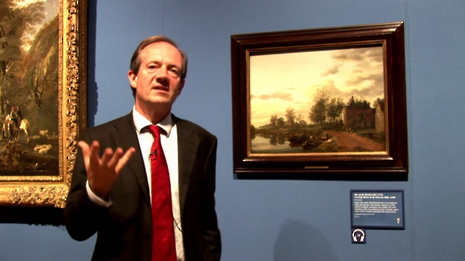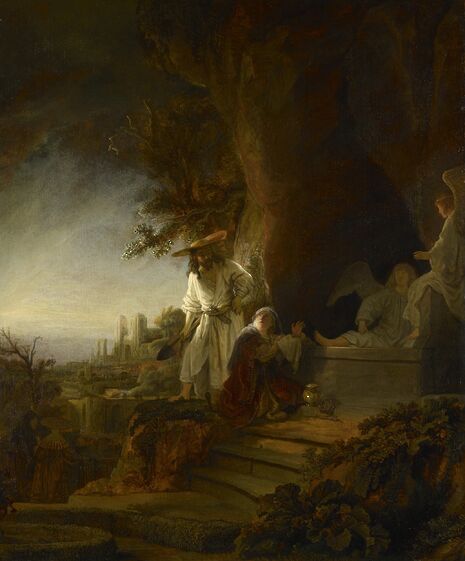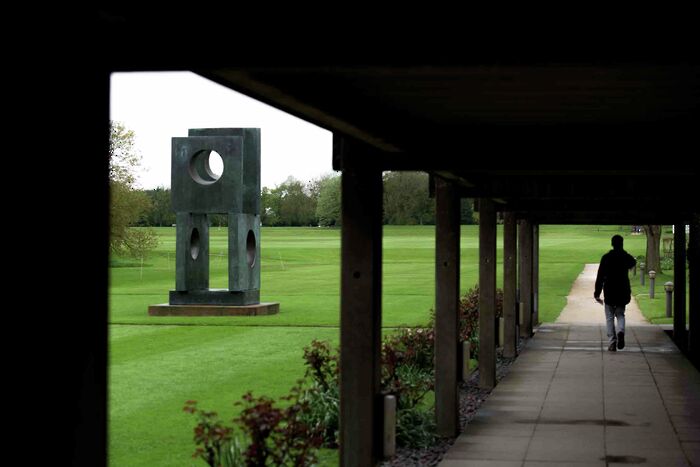Desmond Shawe-Taylor: ‘Art is not elitist – we’ve decided to make it elitist’
The Surveyor of the Queen’s Pictures on elitism in art, curating the largest private collection in the world, and the exhibition of a lifetime

“We collectively as a society have decided to deprive a whole swathe of the population of access to art.” This would be a pretty damning indictment of the art world from anyone, what makes it doubly so is that it comes from a consummate insider. Desmond Shawe-Taylor is the Surveyor of the Queen’s Pictures, tasked by the Royal Household with curating the largest private art collection ever assembled. Shawe-Taylor is the 25th person to hold the post, the office originally being established in 1625, and succeeds various luminaries of the British cultural establishment who once had the job. Kenneth Clark, the original presenter of the recently revived Civilisation was his predecessor, as was Anthony Blunt who although most famous for being a Soviet spy, was also the leading art historian of his day.
You can certainly see why Shawe-Taylor’s assessment is so grim. He notes that only seven state schools in the UK offer History of Art as a subject, the result being that many people “simply do not know that this whole area of study and interest exists.” History of Art A Level has been completely axed from 2018 onwards. He could just as well have pointed to tertiary education. The Courtauld has one of the highest percentages of privately educated students of any university, just behind the Royal Academy of Music. The majority of Cambridge’s History of Art intake in 2017 came from independent schools.
Inevitably this has led to an unrepresentative cultural elite. The National Theatre has had six directors since its foundation, four of whom went to Cambridge. Many of our most celebrated authors and poets such as Martin Amis, Julian Barnes, Alan Hollinghurst or Andrew Motion all attended Oxbridge. The surveyor of the Queen’s Pictures is no exception. The last five back to 1934 all attended four elite public schools. Blunt was a distant cousin of the Queen Mother. As Shawe-Taylor puts it, the exclusivity of high culture has become something of a “self-fulfilling prophecy.”
“You just annoy people if you ask for things which are just too off limits”
But Shawe-Taylor’s frankness as to the extent of the problem is obviously accompanied by a drive to tackle it. He eagerly highlights the work done at the Royal Collection to combat lack of access, citing the current digitisation of the collection, (no mean feat considering that it holds over a million objects), as something which he and his colleagues take “incredibly seriously.” Nevertheless Shawe-Taylor is candid as to the challenges posed by the Royal Collection. Given that the collection is held in trust by the monarch, much of it is held in royal residences with hefty admission fees. “I’m just stupid if I can’t see the negatives... a palace is never going to be as accessible as a public art gallery,” says Shawe-Taylor, although he argues that as these spaces are in effect “mass tourist venues,” they themselves are not particularly “intimidating.” He concedes, however, that there probably are “all sorts of things we’re not doing because we’ve never thought they needed to be done.”
But it’s not only ignorance of existent problems which worries Shawe-Taylor, but also how you go about solving those issues you are already aware of. He points to “demystifying understanding of art” as key to attracting a wider audience, acknowledging that much of the artistic canon was “created for an elite with all sorts of elite baggage,” and solving that, Shawe-Taylor warns, “that’s kind of a lifetime’s work.”
But he is loath to say the art itself is necessarily unapproachable; one gets the sense that it’s precisely his conviction that these works are of undeniable artistic brilliance, something appreciable by any audience, which explains his concern with accessibility. He points to the danger that the “failure [of access] becomes a kind of a way of almost deciding that that we can reject art entirely because it’s an elitist thing.” For Shawe-Taylor, the problem is fundamentally one of perception. “Art is not an elitist thing. We’ve decided to make it elitist… we blame the art rather than blaming ourselves.”

This enthusiasm of Shawe-Taylor to “demystify” the collection is clearly informed by the sheer richness of the art he curates. The collection holds six Rembrandts, seven Holbeins, eight Raphaels, 13 Rubens, 26 Van Dycks and 600 Da Vinci sketches to name but a few treasures. If not for the Civil War, the collection would have an even more extraordinary inventory. Charles I was, as a British monarch, unparalleled in his patronage of the arts, the “greatest moment of glory” for the collection as Shawe-Taylor puts it. But in 1649 Charles was executed, walking on his way to the scaffold under Ruben’s enormous Apotheosis of James I, depicting the deification of his father.
Much of the collection was sold off under Cromwell. “It’s a bit like the dark family tragedy that nobody will talk about” says Shawe-Taylor, like “the moment when the castle in Ireland was sold,” (a cursory check of Shawe-Taylor’s Wikipedia page makes me think this is a rather personal example). With the dissolution of the collection a Rembrandt went for £6, a Titian was given to the royal plumber to settle debts, and Da Vinci’s Salvator Mundi which sold in November for $450m was valued at £30, or about the price of five cows in 1650. Although some of the art was reacquired with the Restoration, innumerable works were never recovered and are now dispersed across the world.
So understandably Shawe-Taylor was delighted when his long-standing ambition of reassembling Charles’s collection finally came to fruition early this year in an exhibition at the Royal Academy, helped with significant loans from the Royal Collection. “Everybody always said this [was] an impossible exhibition to achieve,” says Shawe-Taylor, admitting that he himself thought it unattainable. The idea was actually spontaneously conceived while hiking with Christopher Le Brun, the president of the Royal Academy: “I happened to be staying with Christopher le Brun, and he was talking about [the Royal Academy’s] 250th anniversary. And he said ‘OK right what should we do?’ And I kind of in idle conversation, not seriously, we were all strolling up a hill somewhere, said ‘oh well we should do Charles I’. And he said ‘oh ok that’s what we’ll do.’”
The actual negotiation of the loans from the relevant museums was rather more challenging. “Everyone is fantastically on side but it’s a hell of an ask,” says Shawe-Taylor, “you just annoy people if you ask for things which are just too off limits.” Even though they were “very fortunate” with the loans they did eventually get, he laughingly bemoans that he “could conduct the rest of this interview on fantastically great works which could not be acquired.” Nevertheless the exhibition presented exceptional pieces, from Titian’s magisterial depiction of Charles V, to Ruben’s vibrant allegory Peace and War, and of course van Dyck’s equestrian portraits of Charles I. In the extraordinary Charles I at the Hunt the viewer seems to have stumbled across the monarch in the field, Charles turning to look at us with an enigmatic gaze, somewhere between mournful and challenging, while in the background his pastoral kingdom undulates down towards the sea. Shawe-Taylor certainly seems merited in his assessment of the show as a “once-in-a-lifetime experience.”
Given the astonishing quality of the collection I’m curious to know whether Shawe-Taylor has a favourite work. He answers with impressive decisiveness: “There is a painting that has a kind of extraordinary appeal which is a Rembrandt, Christ and St Mary Magdalen at the Tomb, which I’m very attached to. It’s got this combination of something extremely passionate and moving but also quite funny. The vision of the Magdalen with the risen Christ just at the moment at which she recognises him, having mistaken him for gardener [is] very serious. But then there’s this couple of angels who have just been removing the stone in order that Christ might rise from the sepulchre, and they look like workmen having a cup of tea after a hard day.” “That,” says Shawe-Taylor, “is an incredible and very rare thing in art.”
 Comment / Plastic pubs: the problem with Cambridge alehouses 5 January 2026
Comment / Plastic pubs: the problem with Cambridge alehouses 5 January 2026 News / Cambridge businesses concerned infrastructure delays will hurt growth5 January 2026
News / Cambridge businesses concerned infrastructure delays will hurt growth5 January 2026 News / Cambridge academics stand out in King’s 2026 Honours List2 January 2026
News / Cambridge academics stand out in King’s 2026 Honours List2 January 2026 News / AstraZeneca sues for £32 million over faulty construction at Cambridge Campus31 December 2025
News / AstraZeneca sues for £32 million over faulty construction at Cambridge Campus31 December 2025 Interviews / You don’t need to peak at Cambridge, says Robin Harding31 December 2025
Interviews / You don’t need to peak at Cambridge, says Robin Harding31 December 2025










